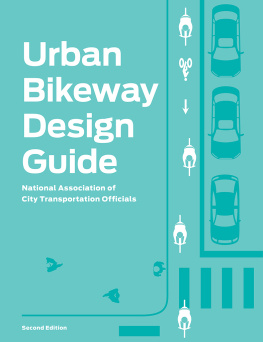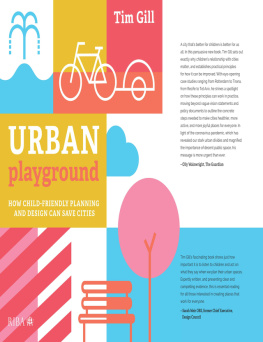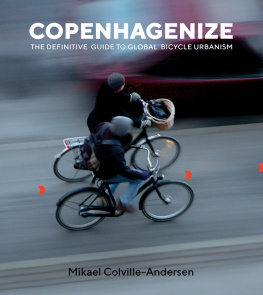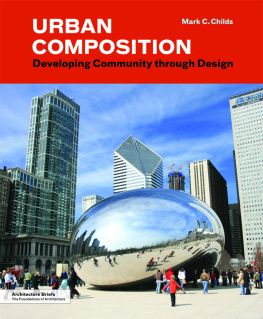Urban
Bikeway
Design
Guide
About Island Press
Since 1984, the nonprofit Island Press has been stimulating, shaping, and communicating the ideas that are essential for solving environmental problems worldwide. With more than 800 titles in print and some 40 new releases each year, we are the nations leading publisher on environmental issues. We identify innovative thinkers and emerging trends in the environmental field. We work with world-renowned experts and authors to develop cross-disciplinary solutions to environmental challenges.
Island Press designs and executes educational campaigns in conjunction with our authors to communicate their critical messages in print, in person, and online using the latest technologies, innovative programs, and the media. Our goal is to reach targeted audiencesscientists, policymakers, environmental advocates, urban planners, the media and concerned citizenswith information that can be used to create the framework for long-term ecological health and human well-being.
Island Press gratefully acknowledges major support of our the work by The Agua Fund, Inc., The Andrew W. Mellon Foundation, Betsy and Jesse Fink Foundation, The Bobolink Foundation, The Curtis and Edith Munson Foundation, Forrest C. and Frances H. Lattner Foundation, G.O. Forward Fund of the Saint Paul Foundation, Gordon and Betty Moore Foundation, The Kresge Foundation, The Margaret A. Cargill Foundation, The Overbrook Foundation, The S.D. Bechtel, Jr. Foundation, The Summit Charitable Foundation, Inc., V. Kann Rasmussen Foundation, The Wallace Alexander Gerbode Foundation, and other generous supporters.
The Opinions expressed in this book are those of the author(s) and do not necessarily reflect the views of our supporters.
Urban
Bikeway
Design
Guide





Edward Reiskin, President,
NACTO, Director, San Francisco Municipal
Transportation Agency
Janette Sadik-Khan,
Chair, Strategic Advisory Board
Linda Bailey,
Acting Executive Director
David Vega-Barachowitz,
Director, Designing Cities initiative
NACTO encourages the exchange of transportation ideas, insights and practices among large cities while advocating for a federal transportation policy that prioritizes investment in infrastructure in the nations cities and their metropolitan areas home to a majority of Americans and hubs of economic activity. Large city transportation officials are investing in innovative public transportation, bike, pedestrian and public space projects to create more sustainable, livable, healthy, and economically competitive cities.
National Association of City
Transportation Officials
55 Water Street, 9th Floor
New York, NY 10041
www.nacto.org
Cataloging-in-Publication Data has been applied for and may be obtained from the Library of Congress.
ISBN: 9781610914369
Copyright 2014 National Association of City
Transportation Officials
Second Edition
The most current version of the Guide is available at c4cguide.org. Copies may be purchased through the National Association of City Transportation Officials (www.nacto.org/print-guide/). Updates and addenda to the Urban Bikeway Design Guide will be posted on the NACTO website.
Design: Pure+Applied (pureandapplied.com)

Washington | Covelo | London
www.islandpress.org
All Island Press books are printed on recycled, acid-free paper.
Contents
Foreword
Since the publication of the first edition of the NACTO Urban Bikeway Design Guide in 2011, the progress made for bicycle safety in US cities had been nothing short of astonishing. The number of miles of protected bike lanes across the country has grown exponentially. Cities from Houston to Lincoln, Nebraska to San Diego are now proactively redesigning their streets for bicyclists, using the NACTO Guide as their go-to source for world-class design. At the same time, support has steadily grown among some of NACTOs key partners, culminating in an August 2013 FHWA Memorandum that expresses full support and endorsement for the Bike Guide itself. Two states, Massachusetts DOT and Georgia DOT, officially adopted the Bike Guide in 2013.
As the landscape changes for bicycling on US streets, so too has NACTO witnessed a year of transitions. Longtime NACTO President and former NYC DOT Commissioner Janette Sadik-Khan has passed the baton to me, as she moves into a new position with NACTO as the chair of the organization's new strategic advisory board. Under her leadership, NACTO has grown from a shoestring operation into a leader in transportation policymaking and a barometer for innovation at the local level. In fall 2013, under NACTOs Designing Cities initiative, NACTO released its first companion volume to the Bike Guide, the Urban Street Design Guide. That document is the first of its kind to comprehensively integrate the most up-to-date bicycling infrastructure guidance into a document that addresses pedestrian, bicycle, transit, and motorist design issues.
The product of an unprecedented coalition of local actors and designers, the NACTO Urban Bikeway Design Guide is actively transforming how our cities think about streetswhom they are for, and how they might be best used. In our member cities, this design guidance is being translated into a series of game-changing street projectsbikeways that funnel people through the heart of the city into our cherished neighborhoods, from greenways to waterfronts, and from homes to businesses. While our efforts in this arena are just getting started, NACTO is fully committed to accelerating innovation and world-class design in this exciting field. In 2014, NACTO will focus on encouraging federal, state, and local adoption of this Guide, as well as the Urban Street Design Guide. We will also continue our work to support cities in their implementation of projects, providing tools and sharing best practices to get these projects built. We welcome your participation in helping us to make the public realms of our cities safer and more enjoyable.
Edward Reiskin
NACTO President
Director, SFMTA
Introduction
The purpose of the NACTO Urban Bikeway Design Guide (part of the Cities for Cycling initiative) is to provide cities with state-of-the-practice solutions that can help create complete streets that are safe and enjoyable for bicyclists.
The NACTO Urban Bikeway Design Guide is based on the experience of the best cycling cities in the world. The designs in this document were developed by cities for cities, since unique urban streets require innovative solutions. Most of these treatments are not directly referenced in the current version of the AASHTO Guide to Bikeway Facilities, although they are virtually all (with two exceptions) permitted under the Manual on Uniform Traffic Control Devices (MUTCD). The Federal Highway Administration has posted information regarding MUTCD approval status of all of the bicycle related treatments in this guide. All of the NACTO Urban Bikeway Design Guide treatments are in use internationally and in many cities around the US.1


















